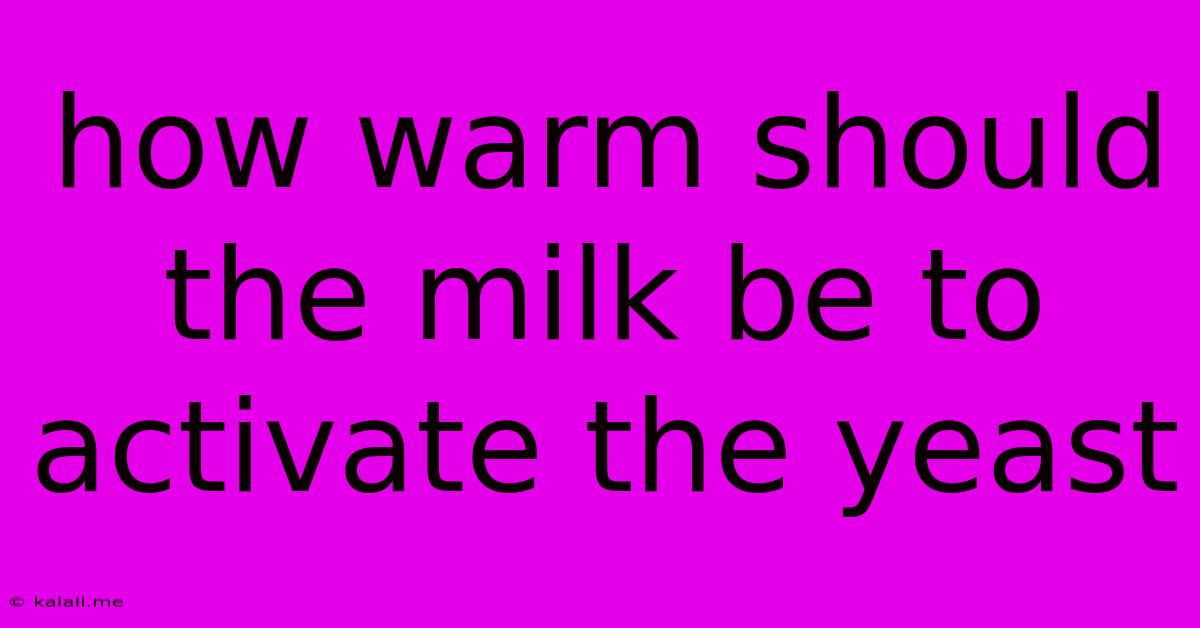How Warm Should The Milk Be To Activate The Yeast
Kalali
Jun 04, 2025 · 3 min read

Table of Contents
How Warm Should Your Milk Be to Activate Yeast? The Perfect Temperature Guide
Getting the temperature of your milk just right is crucial for successful baking. Yeast, a living organism, needs a specific temperature range to thrive and activate properly. Too cold, and it'll slumber; too hot, and you'll kill it, resulting in a flat, disappointing loaf. This guide will help you achieve the perfect milk temperature for activating yeast and unlocking the full potential of your baking.
Understanding Yeast Activation: Why Temperature Matters
Yeast, a single-celled fungus, feeds on sugars and produces carbon dioxide as a byproduct. This gas creates the air pockets that give bread its light and airy texture. For yeast to effectively consume sugars and produce CO2, it needs to be in an optimal temperature environment. The ideal temperature range for yeast activation is between 105°F and 115°F (40°C and 46°C).
Methods for Checking Milk Temperature
There are several ways to accurately check the temperature of your milk:
-
Using a Thermometer: This is the most accurate method. A digital thermometer is best, as it gives you a precise reading. Simply submerge the thermometer into the milk and wait for a stable reading.
-
The "Wrist Test": This method involves testing the milk's temperature against your wrist. Pour a small amount of milk onto your wrist. If it feels comfortably warm, almost like your own body temperature, it's likely in the right range. However, this is less precise than using a thermometer.
-
The "Touch Test": Gently dip your finger into the milk. If it feels lukewarm, not hot or cold, it might be suitable. Again, this is less reliable than a thermometer.
What Happens if the Milk is Too Hot or Too Cold?
-
Too Hot (above 115°F/46°C): You'll essentially cook the yeast, killing it and preventing it from rising. Your bread will be dense and flat.
-
Too Cold (below 105°F/40°C): The yeast will become dormant and won't activate properly. The rising process will be slow, or it may not rise at all, leading to a dense loaf.
Tips for Achieving the Perfect Milk Temperature:
-
Warm the milk gradually: Use a microwave in short bursts or heat the milk on the stovetop over low heat, stirring frequently to prevent scorching. Constantly monitor the temperature using a thermometer.
-
Let the milk cool slightly: If the milk gets too hot, let it cool down to the ideal temperature before adding the yeast. It's better to err on the side of slightly cooler milk than too hot.
-
Use lukewarm water as an alternative: If you are not using milk in your recipe, you can activate your yeast with lukewarm water instead. The same temperature guidelines apply.
Troubleshooting Yeast Activation Issues:
If your yeast isn't activating, even with properly tempered milk, consider these factors:
-
Yeast freshness: Check the expiration date on your yeast. Old yeast might be inactive.
-
Ingredient quality: Make sure you're using fresh ingredients, especially flour and sugar, as their quality can impact yeast activity.
-
Altitude: At higher altitudes, yeast may need a slightly higher temperature to activate.
By carefully monitoring the temperature of your milk, you can ensure successful yeast activation and achieve perfectly risen, delicious baked goods. Remember, a thermometer is your best friend for consistent results!
Latest Posts
Latest Posts
-
Jesus Washed The Feet Of His Disciples
Jun 06, 2025
-
How To Remove Background On Gimp
Jun 06, 2025
-
How Do Heat Pumps Work In Winter
Jun 06, 2025
-
Is White Wine Vinegar The Same As White Cooking Wine
Jun 06, 2025
-
I Have A Question For You
Jun 06, 2025
Related Post
Thank you for visiting our website which covers about How Warm Should The Milk Be To Activate The Yeast . We hope the information provided has been useful to you. Feel free to contact us if you have any questions or need further assistance. See you next time and don't miss to bookmark.